What is it?
The simple karaoke circuit takes a stereo line level audio signal from a CD player, mp3 player or similar and, in the case of most music recorded in the last 2 or 3 decades, significantly reduces the volume of the vocals without removing much of the accompaniment.
How on earth do you achieve this?
Simple. It’s to do with the way most pop and rock music is recorded. To generate a stereo image, you can simply record instruments with different levels on each of the left and right channels, giving a sense of position to the listener. A much more common technique is to use equalizers to filter very narrow frequency bands and alternate these between the two channels. Either way, the instruments are usually different on the left and right channels. The vocals, on the other hand are supposedly considered to be much more important and get themselves recorded identically on both channels. The long and the short of it is that if you subtract one channel from the other, the vocals cancel out and you get a very good karaoke effect. If you don’t believe me, try it in a wave editor. Simply invert one channel and then blend them. This circuit does exactly the same thing, although being based on analogue, electronics, it can be built cheaply with a handful of parts and unlike the wave editing method, can do it on the fly, without the need for a computer.
The karaoke circuit itself
In this circuit, I have heavily used op-amps. If you don’t know what an op-amp is, or want to know a little about the most common 3 configurations, check out my opamp tutorial. Figure 1 shows the left channel’s input circuit. As you can see, opamp U1A is configured to be inverting with a gain of just over 2. For maximum flexibility, I have designed the entire circuit to operate of a single supply rail of VCC and earth. Later you’ll see how this supply is divided in half to produce VCC/2 which is connected to various points in the circuit. C1 acts as a DC block between the input, which is biased to ground and the opamp input which is biased to VCC/2.

Figure 2 shows the right channel. It is very similar except that it is not inverting. Again, the gain is approximately 2. Both the left and right inputs use opamps from the same integrated circuit. I have used the TL074 which is a low noise FET input opamp. This design does not call for a FET input but this will not be discussed here. Basically, I built this circuit to ensure it works well and discovered that the common, cheap, LM324 opamp caused an unacceptible amount of distortion. I may have had a bad chip but it was my only one. I use TL074s in practically all my audio designs as they are high quality and with 4 in one chip are the best value out of the TL07X range.
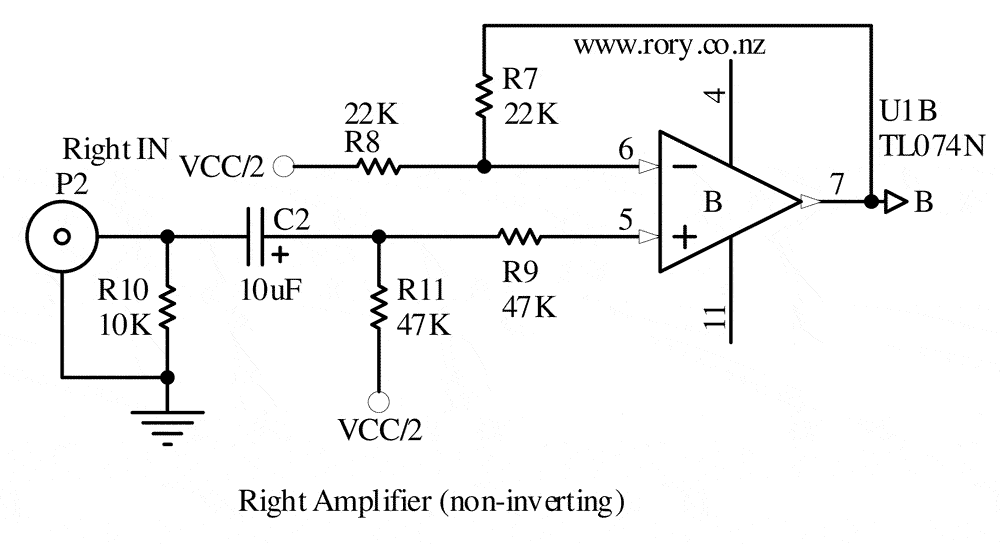
Having acquired an inverted version of the left channel and a similar amplitude version of the right channel, we now mix them together. This is done by connecting the signals to a common point via resistors R5 and R6. The trimpot, R15 allows a number of things. Initially, it was put in for calibration to compensate for the ratio of 47K to 22K not being exactly 2 as well as variations in component values. However, upon testing, I discovered that the karaoke effect was too good on some songs, cancelling almost everything and not leaving enough original for the singer to be able to stay in time. I reccommend that the singer have headphones through which to hear the original for this reason, but you can uncalibrate the circuit somewhat to allow a bit more music and vocals through. In a small proportion, this is necessary to prevent the song being totally ruined by the circuit. I suggest you use a pot with a knob as opposed to a trimpot, operated by a screwdriver to allow easy adjustment during use. I have made R5 and R6 different values to allow more precise adjusting of this as more of the pot range is spread over the calibrated and uncalibrated in one direction than the other. U1C provides some gain to make up for losses due to cancellation so that the amplitude of the karaoke’d signal is similar to that of the non karaoke’d signal. S1 chooses between the two, allowing the original to be played, albeit mono, without swapping cables. Trimpot R17 should be adjusted after construction to ensure that when S1 is toggled there isn’t a significant change in volume 😉
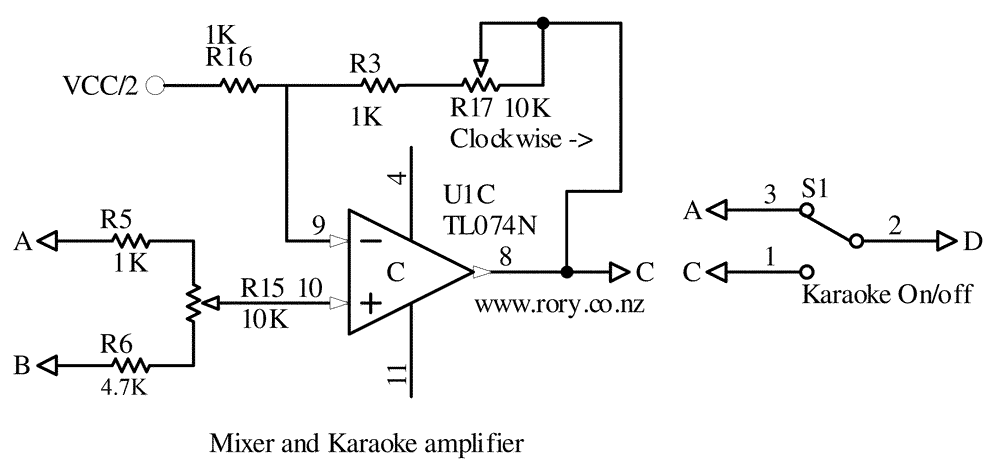
Having successfully karaoke’d the music, it is now just a simple matter of outputting it to your amplifier. Figure 4 shows how to do this. It is just a matter of level shifting the DC to be at ground potential. This is done by C3 and R12.
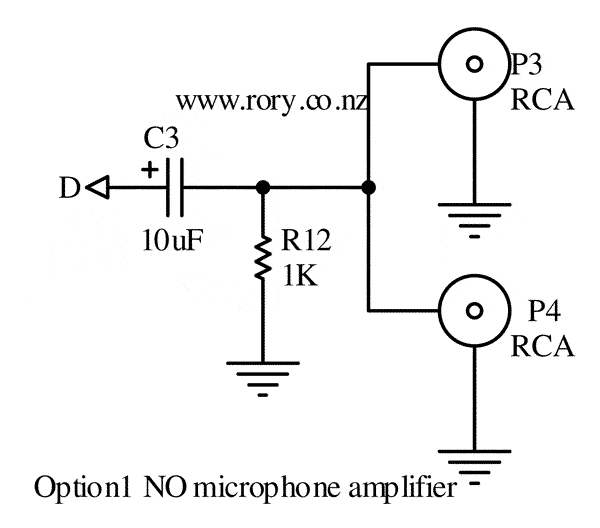
But what about the microphone!!!
So I’ve shown you how to make a karaoke of your favourite music, but where do you connect the microphone to sing along? Well that’s a good question. This is where it gets a little complicated for several reasons, but I will try to talk you through it in a simple, concise manner. First, you will need to work out what type of microphone(s) you wish to use. (Yes you may use multiple for duets etc!). If you don’t know what kind of microphone you have, with a multimeter, measure the resistance of the microphone. If it is in the hundreds of ohms, 400 and 600 being common, it is a dynamic microphone, utilising a moving coil. If, however, it is more than 1000 ohms, it is most likely an electret microphone, based on a moving capacitor with a transistor amplifier built into the microphone. Most headset microphones are electret microphones, while most hand held microphones are dynamic. Dynamic tend to be larger than electret. So why do we care? Well electret microphones give out a much larger signal than dynamic microphones as they have a built in amplifier. However, this amplifier needs power to operate. I have designed the Microphone frontend, shown in figure 5 to provide this power via R4, without interferring with dynamic microphones which do do need it. The microphone frontend simply amplifies the signal from the microphone by a factor of between 1 and 100 depending on the setting of R1. This can be used as a sort of volume control, although it will never quite mute the microphone.
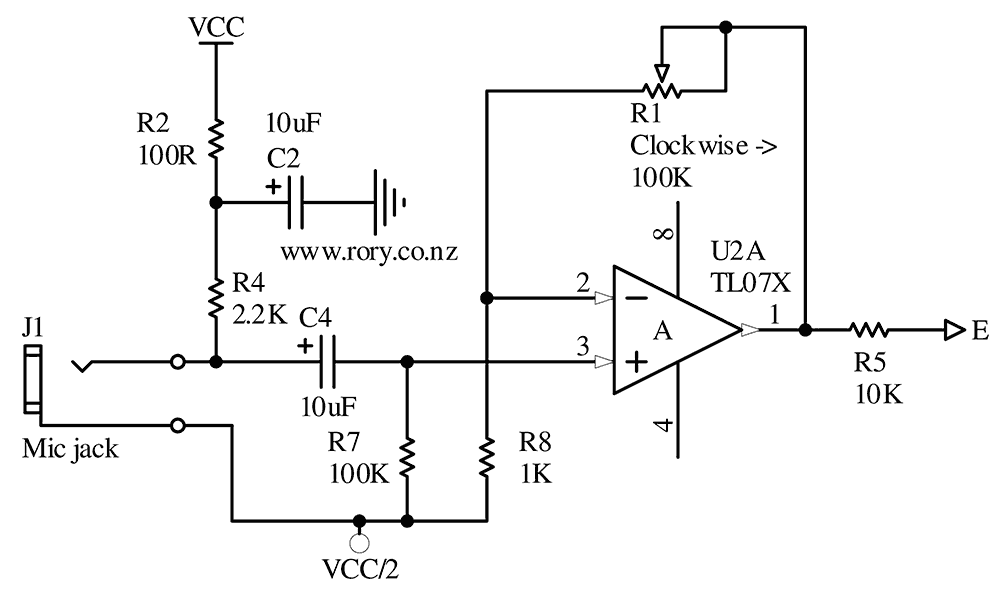
Option 2: Electret microphone(s) only
(Option 1 was to not have a microphone remember?). In this case, all we have to do is take the signal from your microphone(s) at point E in figure 5, connecting them together if you have more than 1, and feed this signal to point E in figure 6. Figure 6 shows a mixer that combines the microphone and karaoke signals via R5 on each frontend and R3 on the mixer. U2B then buffers the signal to be outputted after the level shifting reminiscent of option 1. If you only have 1 microphone, you will need 1 opamp for the frontend and one for the buffer. In this case you can use a TL072 dual opamp. Note that while the pin numbers for opamps A and B are the same as with the TL074, the positive power pin differs. On the TL072, it is pin 8 as shown in figure 6.
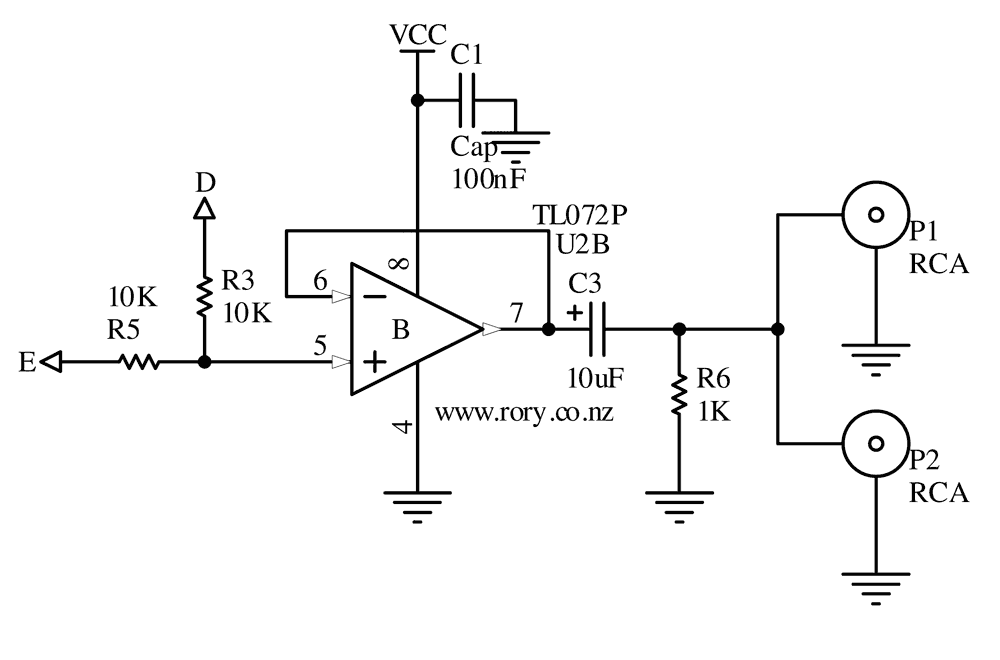
As mentioned, you can have 3 microphones, by simply building 3 of figure 5 and one of figure 6. You would need to use a TL074 quad opamp. The pinouts of both opamps are shown in figure 7 for clarity from the manufacturer’s datasheet.

Option 3: Dynamic microphone
If you wish to use a dynamic microphone, you are going to find that the circuit shown above is not going to give enough gain. Adjusting the feedback network will also not give good results, so I suggest an extra amplifying stage. Figure 8 shows how you would do this. Note that the right hand side is exactly the same as figure 6 but the left is an amplification stage with a gain of 10. This gets multiplied by the frontend’s 1 to 100 giving an overall gain of 10 to 1000. If you connect an electret microphone to this arrangement, you will find that you have to keep the gain pot very low and that it is hard to set. However, there are work arounds. Connecting a frontend to point E on figure 8 will allow you to use a dynamic microphone. If you wish to change to an electret microphone, just short circuit R10. This can be done with a switch if needed. Alternatively, if you want to have a combination of electret and dynamic microphones, connect the frontends for the electret microphones point E’s to point F on figure 8 instead of point E. You may as well make one frontend for dynamic and one for electret if you want to be flexible as you will need 3 opamps to do a single dynamic and opamps come in single, dual or quad packages. Obviously quad will be the most cost effective (cheaper than a single & a dual) and gives a spare opamp so why not use it! Again, if you wish to have more microphones, just make more frontends.
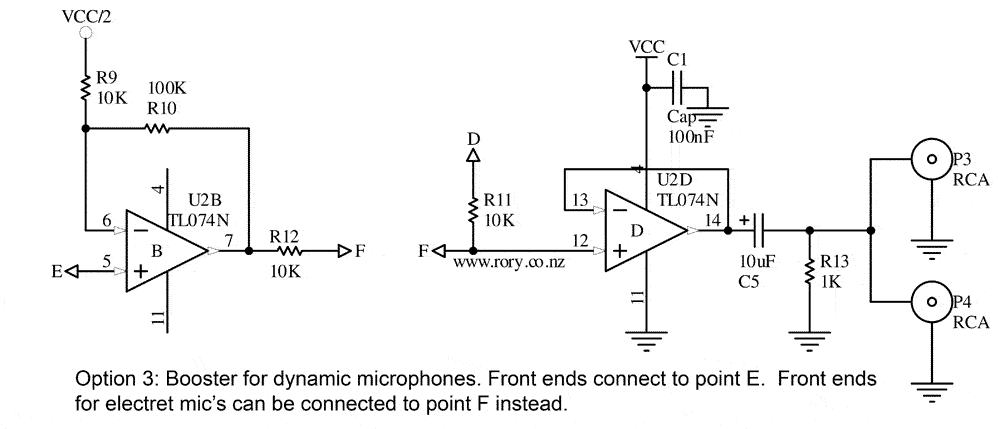
That VCC/2 thing
Audio is AC, that is, it has positive and negative cycles. I’ve mentioned in places how the circuit is all biased to operate around VCC/2 whilst the inputs & outputs operate around ground. This is so that you do not have to use a split power supply, simplifying power supply design. For example you can use a 9-16 volt plugpack or “wallwart”. You can also get away with a 9 volt battery, though I doubt it would last terribly long, perhaps a few hours. Figure 9 shows how VCC/2 is derived and where the “missing opamp” from U1 is. R13 and R14 form a resistive divider network, giving 4.5volts in the case of a 9 volt battery. This is buffered by U1D to give a low impedance VCC/2. Apart from that it’s pretty simple, though there are 2 points I’d reccomend doing. If you use a plugpack, particularly if it is unregulated, it would pay to increase C4 to 2200uF. Also, if you wish to operate from a battery, you can reduce power consumption a little by changing R13 and R14 to 100K BUT you should also add a 10uF capacitor in parallel with R13 as the switch on time constant will be too long otherwise. As always, switch audio systems on in order from microphones & audio sources, to the karaoke circuit to finally, your amplifier. Reverse the switch off process. This will eliminate thumps. And it’s pretty general knowledge but I will mention anyway that the multiple opamps shown from the same integrated circuit share their power pins. I have only shown the power connected once. Make sure you connect all chips and put the decoupling capacitors i.e. C6 for U1 as physically close as possible to the power pins.

A note about pots
Pots come in many shapes and forms. One of the two main differences is whether they are a full pot that you turn a knob or shaft with your hand or a “trimpot” that is one that you adjust with a screwdriver. This project uses a mixture. The gain of the karaoke can be a (cheaper) trimpot while the rest are best implemented as full pots for easy adjustment. The other difference in pots is whether they have a linear or logarithmic taper. A log taper means that half of the physical travel will translate to half the range of resistance. For example, on a 10K pot, 10% change results in a change of 1K. On a log taper, in theory, it is a log function. However, in practice, log pots just use 2 different tapers unless they are very fancy $50+ pots as opposed to the usual $3-$10 pots. (Rough ballparks, NZD or USD). This project uses linear pots only. (Trimpots are usually only available in linear by the way.) Log is usually used for audio as our ears perceive volume logarithmically causing 10 times the power to sound twice as loud for example. The reason I don’t use them here for gain is A, you are getting a log function by the ratio of the pot to fixed resistor anyway and B, the taper goes the wrong way as it is configured for volume pots not gain. Which leads me to my next point. You must wire the pots as shown in figure 10 so that when turned clockwise, the resistance gets HIGHER. This is because the pots, with the exception of the trimpot are in negative feedback networks of opamps which, as you know increase their gain with less negative feedback. Please excuse the poor quality photo, my camera is on it’s last legs.
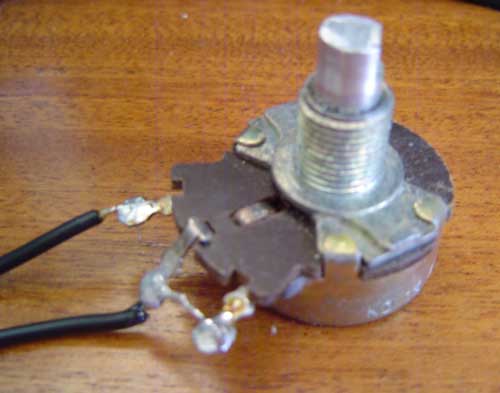
One last point about pots, log pots are usually marked with an A whilst linear pots are marked B.
As always, if you build this project or any part of it, I would love to know how it went, any errors or just that you built it. Let me know in the comments section. 🙂
References
[1] TL07X opamp family datasheet. You can download this from the Texas Instruments website at http://focus.ti.com/docs/prod/folders/print/tl074.html
Full schematic
Here is the full schematic, split into two pages for printing. Click to enlarge.
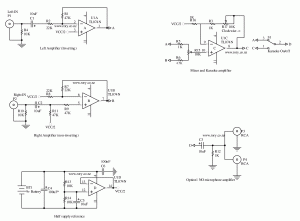
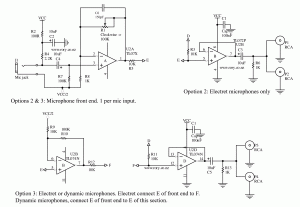
do you have reference book?
No I don’t. Was there something specific you were looking for information about?